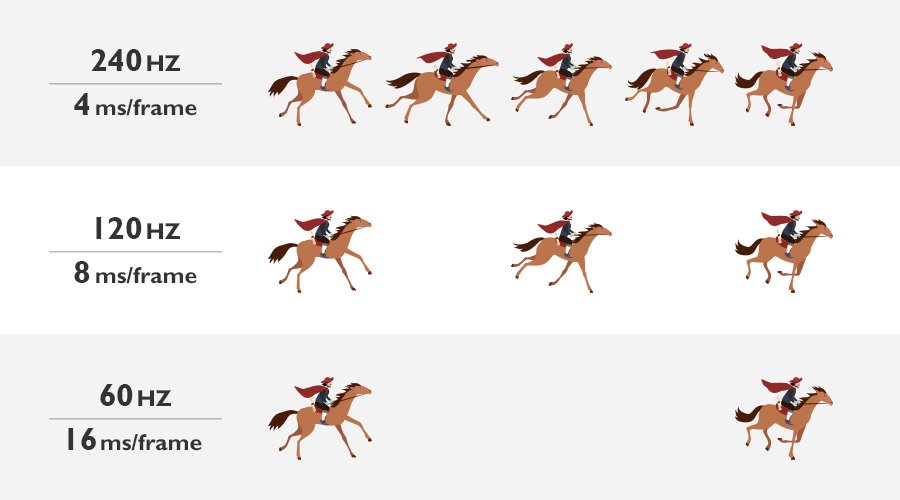Yes, new gen gaming projectors now offer 1080p 240Hz / 120Hz and 4K 60Hz with minimal input lag. High refresh rates and huge screens make projectors a very attractive choice for console and PC gamers.

2024/03/29
Yes, new gen gaming projectors now offer 1080p 240Hz / 120Hz and 4K 60Hz with minimal input lag. High refresh rates and huge screens make projectors a very attractive choice for console and PC gamers.

Measured in Hz or frames per second, refresh rate means the number of times a monitor updates the entire panel or frame each second. The faster that number, the smoother the gameplay experienced by users. For a long time, 60Hz or 60 frames per second (fps) was considered standard, but improved technology has made higher or faster monitors possible.
Refresh rate is not the same as response time, which is the speed with which the monitor updates individual pixels, but refresh rate and response time together do result in total input lag figures. That the total time required between pressing a button and the result showing on the screen, and for that you want the lowest number possible.

Also referred to as HRR, high refresh rates generally mean 120Hz and over. As you probably know, gaming monitors now routinely do 144Hz and even 240Hz, albeit in lower resolutions and with toned down graphics settings. On PC, 60Hz has been the minimum “acceptable” framerate for a long time, and now consoles have also caught up. In short, 60 frames per second regardless of resolution is considered the baseline for enjoyable gaming.
Without getting into lengthy explanations, framerate helps determine gaming enjoyment because video games by their nature need to be responsive and feel smooth when you interact with them. Lower frame rates cause everything to seem sluggish and unresponsive, and once you experience 60Hz or more, going back to the old 30Hz standard that dominated consoles between 2005 and 2020 is very jarring.
Current generation consoles have so much power available that even the least motivated developers can easily pull off 60Hz, and that benefits every game genre. First person shooters and racers focus on response and reflexes more than story-driven exploration titles or role playing games, and therefore benefit greatly from uncapped frame rates. If you enjoy FPS titles and racing games, the smoothness of 120Hz and over cannot be understated, and genuinely helps not just in enjoying the game more, but performing better if in a competitive mode.
In summer 2021, the answer to that is a resounding YES. With the arrival of new gaming consoles and graphics cards for PC, 120Hz has finally become a relatively common refresh rate. Many 4K TVs feature 120Hz panels and support for this refresh rate through HDMI 2.1, which Xbox Series X/S and PlayStation 5 feature, as do the latest NVIDIA and AMD graphics cards. TVs have also improved their response with lower input lag.
But so have gaming projectors. Native 4K 60Hz at just 16ms is a reality with the kind of gaming projector you’d like in your setup, and full HD 1080p at 120Hz with 8ms / 240Hz with just 4ms is also a firm reality. The old perceptions of gaming and projectors being mutually exclusive don’t apply anymore. Times and technology have changed.
Gaming has come to projectors big time. The BenQ Gaming projector embodies this new generation of game-focused light throwers with streamlined processing that ensures minimal latency. The TK710STi does 1080p at 120Hz/240Hz with a mere 8ms/4ms of input lag, perfect for Call of Duty or something like Rainbow Six, where resolution and graphics settings aren’t the most important things, because refresh rate is. Until recently, 120Hz on a gaming projector would have been unheard of, but now it’s very doable.
While not technically high refresh rate by most definitions, native 4K 60Hz is very impressive and now the gold standard for new generation console and PC games. Pushing out 120Hz 4K with high settings is still a challenge for most developers, but 60 frames per second appears to work great increasingly. That’s why the BenQ X3100i, X500i, X300G and TK710STi are such wonder, doing 4K 60Hz with just 16ms of input latency, which is very competitive with even the fastest TVs.
The biggest plus for projectors is screen size. TVs have nothing on projectors here, either in sheer specs or in cost per inch of screen. With the two BenQ gaming projectors we mentioned you can easily have your gaming on a 100” screen. So when you really want to up your game with regards to screen size, a gaming projector is the path of choice because the “wow factor” of a massive, high speed, crisp and detailed screen simply can’t be denied.
The Hardware Challenge: Can Your PC Handle 4K 120Hz?
While 4K 120Hz gaming promises ultra-smooth visuals, the reality is that even the most powerful graphics cards like the NVIDIA RTX Series struggle to deliver these visuals. When running games at maximum settings with 4K resolution, these high-end GPUs often manage only 50-60 fps, falling short of the 120Hz mark. This highlights the limitations of hardware, even at the top end.
Pushing for 4K 120Hz means making compromises. To achieve higher refresh rates, gamers often need to lower visual quality and turn off intricate details, sacrificing the rich, immersive experience many gamers seek. This trade-off can detract from the enjoyment of graphically intensive AAA titles and cooperative games, where visual detail adds to the overall experience.
For those looking for the best gaming experience on a large screen, a 4K 60Hz projector strikes the perfect balance. It offers stunning visuals with smooth gameplay, capturing the essence of epic adventures and fast-paced co-op games without overburdening the hardware. With a BenQ 4K 60Hz projector, you get immersive, cinematic gaming that brings your favorite titles to life in a way that 4K 120Hz setups often can't match.
Choose the Best BenQ Gaming Projector Right for You
Get All the Knowledge About Gaming Projector